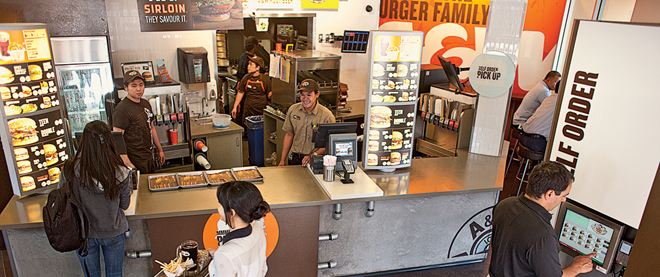Canada still loves A&W
The fast food chain is ‘barely breathing’ in the U.S., but north of the border it’s on a tear
Share

A&W Canada is an old-school company. It opened its first drive-in on Winnipeg’s Portage Avenue in 1956. Many of its executives have been at the company for years, including the CEO, whose first day with A&W was 32 years ago. Most outlets still have a ’50s-inspired decor. And like a humble pro athlete from a bygone era, A&W celebrates its victories—nine consecutive years of same-store sales growth and continued expansion into new markets—quietly. “A&W has kind of always been in the background, just steadily growing,” says Robert Carter, a food industry analyst with NPD Group. “It’s under the radar.”
The home of root beer and Teen Burgers has emerged as the second biggest burger chain in Canada by number of outlets, topping better known rivals like Wendy’s and Burger King. On May 16, it opened its 754th restaurant in Canada. Two weeks earlier, A&W released its first-quarter results, showing sales growth of 3.7 per cent over the same period last year, to $173 million. What makes the success all the more surprising is that in the U.S., where the brand originated in 1919, A&W has been falling off the map. There are only 300 A&Ws in the entire country. “They’re barely breathing,” says Bob Goldin, executive vice-president at the Chicago-based industry consulting firm Technomic.
A&W Canada is a separate company from its American counterpart, and has charted a different course in everything from its branding to menu items. The key to its success, says CEO Paul Hollands, is a willingness to adapt, while at the same time staying true to the character of a brand built largely on baby boomer nostalgia for drive-ins and frosty mugs. “We just keep picking away at the business as the world around us changes,” he says. Up until about 15 years ago, says Hollands, the burger chain was largely absent everywhere except the Atlantic provinces and the West. More recently, its main strategy has been to establish a stronger presence in Ontario and Quebec, regions traditionally dominated by Tim Hortons and McDonald’s. It’s working: on Feb. 8, Hollands was at Toronto’s Pearson International Airport for the opening of the 750th restaurant, making Ontario the province with the most A&W locations.
Hollands claims one key competitive advantage behind the expansion is that, unlike other chains, it offers franchisees the opportunity to open multiple locations in one area.
Like rival McDonalds, A&W has also made an effort to cater to the increasingly “sophisticated” tastes of consumers, says Carter. In August 2010, they unveiled their new “urban concept” restaurant on Robson Street in downtown Vancouver. With the help of Cincinnati’s FRCH Design firm, the newly styled restaurants feature softer lighting, bar seating and an updated menu design. There’s also free WiFi and recyclable food baskets, and customers can order and pay at touch-screen kiosks. Similar outlets can be found in Calgary and Toronto, and Hollands says there are plans for a lot more.
A&W has a long way to go if it’s ever going to catch the fast food behemoth McDonald’s, which has 1,400 locations in Canada. But it continues to quietly plug away. Hollands says plans are already in motion to open another 200 of its orange-hued restaurants nationwide, many of which will land in central Canada.